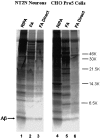Detection of a novel intraneuronal pool of insoluble amyloid beta protein that accumulates with time in culture
- PMID: 9585420
- PMCID: PMC2132781
- DOI: 10.1083/jcb.141.4.1031
Detection of a novel intraneuronal pool of insoluble amyloid beta protein that accumulates with time in culture
Abstract
The amyloid-beta peptide (Abeta) is produced at several sites within cultured human NT2N neurons with Abeta1-42 specifically generated in the endoplasmic reticulum/intermediate compartment. Since Abeta is found as insoluble deposits in senile plaques of the AD brain, and the Abeta peptide can polymerize into insoluble fibrils in vitro, we examined the possibility that Abeta1-40, and particularly the more highly amyloidogenic Abeta1-42, accumulate in an insoluble pool within NT2N neurons. Remarkably, we found that formic acid extraction of the NT2N cells solubilized a pool of previously undetectable Abeta that accounted for over half of the total intracellular Abeta. Abeta1-42 was more abundant than Abeta1-40 in this pool, and most of the insoluble Abeta1-42 was generated in the endoplasmic reticulum/intermediate compartment pathway. High levels of insoluble Abeta were also detected in several nonneuronal cell lines engineered to overexpress the amyloid-beta precursor protein. This insoluble intracellular pool of Abeta was exceptionally stable, and accumulated in NT2N neurons in a time-dependent manner, increasing 12-fold over a 7-wk period in culture. These novel findings suggest that Abeta amyloidogenesis may be initiated within living neurons rather than in the extracellular space. Thus, the data presented here require a reexamination of the prevailing view about the pathogenesis of Abeta deposition in the AD brain.
Figures







References
-
- Borhelt DR, Thinakaran G, Eckman CB, Lee MK, Davenport F, Ratovitsky T, Prada CM, Kim G, Seekins S, Yager D, et al. Familial Alzheimer's disease-linked presenilin 1 variants elevate Abeta1-42/1-40 ratio in vitro and in vivo. Neuron. 1996;17:1005–1013. - PubMed
-
- Burdick D, Soreghan B, Kwon M, Kosmoski J, Knauer M, Henschen A, Yates J, Cotman C, Glabe C. Assembly and aggregation properties of synthetic Alzheimer's A4/beta amyloid peptide analogs. J Biol Chem. 1992;267:546–554. - PubMed
-
- Citron M, Oltersdorf T, Haass C, McConlogue L, Hung AY, Seubert P, Vigo-Pelfrey C, Lieberburg I, Selkoe DJ. Mutation of the beta-amyloid precursor protein in familial Alzheimer's disease increases beta-protein production. Nature. 1992;360:672–674. - PubMed
-
- Cook DG, Forman MS, Sung JC, Leight S, Kolson DL, Iwatsubo T, Lee VM-Y, Doms RW. Alzheimer's A beta(1-42) is generated in the endoplasmic reticulum/intermediate compartment of NT2N cells. Nat Med. 1997;3:1021–1023. - PubMed
Publication types
MeSH terms
Substances
LinkOut - more resources
Full Text Sources
Other Literature Sources

